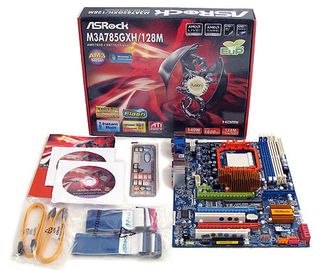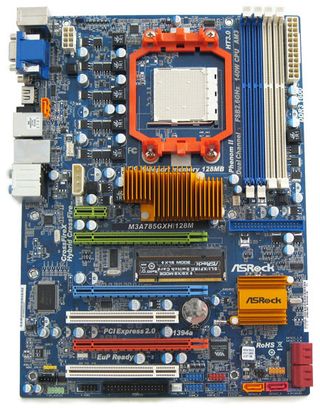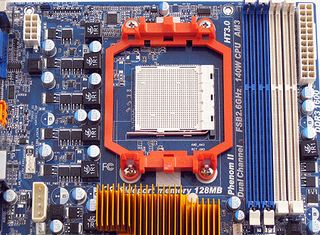Seven AMD 785G-Based Motherboards Rounded Up
ASRock M3A785GXH/128M: Features And Hardware

We'll begin with a look at ASRock's ATX flavor of 785G. The M3A785GXH/128M appears to be aimed squarely at the enthusiast market with 140W CPU support, 1,600 MT/s (overclocked) DDR3 support, 128MB of SidePort on-board memory, and enthusiast-class BIOS control. Despite all of this build-up, the bundle is a little Spartan. It includes an IDE cable, floppy cable, two SATA cables, a manual, two driver CDs, and an I/O panel shield.
The board comes with ASRock's Overclocking Tuner software, Instant Boot functionality (combines the benefits of a total system shutdown with the recovery speed of sleep mode), Intelligent Energy Saver (an AM2+/AM3 feature that disables extra power phases under light loads to save power), and Hybrid Booster (ASRock claims this is a safe overclocking feature because of an integral thermal monitor that protects the CPU from overheating).
I must admit, I'm always a little curious to see what sort of concoction the mad scientists as ASRock will come up with. The M3A785GXH/128M didn't disappoint:

Yes, the board employs three x16 PCI Express (PCIe) 2.0 slots. It relies on the stock 785G/SB710 combo, and the 785G chipset is limited to 16 lanes for graphics. Therefore, available PCI Express connectivity must be shared between the top two PCIe x16 slots for single x16 or dual x8/x8 operation. The third x16-sized slot is limited to four lanes. Single x16x or dual x8 modes for the top two slots are selectable through the use of a switch card, which saves money on automatic switching.

The dual second-gen x8 slots shouldn't have too dramatic an impact on CrossFireX performance, but the x4 slot will most certainly slow down triple-CrossFireX. Either way, the board gives users a lot of nifty options on the graphics card front. Kudos to ASRock for having a budget board that can handle three dual-slot graphics cards.

This board takes power usage seriously, with a eight-pin auxiliary ATX 12V power connector and a four-pin Molex-style connector, in addition to the standard 24-pin ATX power connector. However, the four-pin Molex plug is only necessary for CrossFire operation.
Speaking of power, ASRock claims to be the first manufacturer to support the European Union's Energy Using Product (EuP) standard, which specifies that a system can use no more than one watt of power while turned off.
Stay on the Cutting Edge
Join the experts who read Tom's Hardware for the inside track on enthusiast PC tech news — and have for over 25 years. We'll send breaking news and in-depth reviews of CPUs, GPUs, AI, maker hardware and more straight to your inbox.

ASRock also chose a unique way to allow users to opt for either a sixth internal SATA 3 Gb/s port or an external eSATA port--the eSATA port in the I/O panel is disabled unless the sixth internal SATA port is dedicated to its operation via an included cable. It might not be the cleanest or most elegant solution, but I can tell you from personal experience that it can be frustrating when you could use another internal SATA port that a vendor dedicated to an external eSATA plug.

We found the configuration and placement of components to be a little odd, but serviceable. The 24-pin ATX power plug is on the very top of the board, which might be a problem in enclosures where the power supply is mounted on the bottom. If CrossFire is used, the Molex-style power connector is in an inconvenient place. The IDE connector is oddly-mounted perpendicular to the edge of the board. The floppy connector is on the bottom-left, which makes for messy cable management when legacy devices are used.
Finally, it's nice to see two of the six SATA connectors facing outward from the board. However, they're placed below the panel connectors. The remaining four SATA connectors are placed out of the way on the bottom-right of the board, but they face outward, which, for this writer, was not ideal.
Current page: ASRock M3A785GXH/128M: Features And Hardware
Prev Page Motherboard Features Comparison Next Page ASRock M3A785GXH/128M: BIOS And Overclocking-
JohnnyLucky Very informative article. Nice to see there are motherboards with different features for different users/tasks.Reply -
bpdski Great article, I think this shows pretty conclusively that there is no benefit to upgrading to an AM3 based system. If you already have an AM2+ system, you can easily just drop in a new CPU and you system will be every bit as good as a brand new system with DDR3. You just need to make sure your motherboard supports the power requirements of whatever you want to drop in.Reply -
jonpaul37 Hooray AMD for having cheap solutions in these hard-economic times!Reply
Boo @ Intel! i like the product, but my wallet & Girl do not like the cost! -
jonpaul37Hooray AMD for having cheap solutions in these hard-economic times!Boo @ Intel! i like the product, but my wallet & Girl do not like the cost!+1Reply
Girl has more money for clothes! -
ominous prime Well bpdski there is no point upgrading if you're AM2, but if you're building a new PC AM3 is the way to go in terms of your computers longevity. Very informative article.Reply -
sonofliberty08 thanks alot for the info , my first choice was allways asus , but now i now what i need when im going to unlock core , and now i saw the benefits of sideport memory .Reply -
duzcizgi ReplyWe were successful in achieving a 900 MHz stable overclock with the integrated graphics chipset by setting the BIOS to increase northbridge voltage by +.210mV.
Well, .210 mV = 210 microvolt. I don't think it would make much of a change. Maybe it is 210 mV or, .210 V. :) -
doron "Now we're seeing another benefit for the AM2+/DDR2 boards: both the Foxconn Cinema Premium and Biostar TA785GE 128M are drawing less power than their AM3/DDR3 counterparts."Reply
How comes? Didn't we all agree a long time ago that ddr3 supposed to be more energy efficient out of the two? (Lower voltage and stuff?) -
DarkMantle Great article, this will help a lot of people to make their AMD budget motherboard choice easier, thank you Don.Reply
Most Popular

